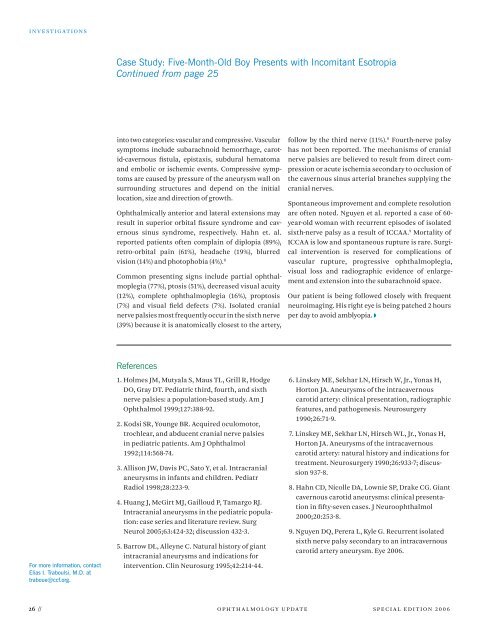Ophthalmology Update - Cleveland Clinic
Ophthalmology Update - Cleveland Clinic
Ophthalmology Update - Cleveland Clinic
You also want an ePaper? Increase the reach of your titles
YUMPU automatically turns print PDFs into web optimized ePapers that Google loves.
i n v e s t i g a t i O n s<br />
For more information, contact<br />
Elias I. Traboulsi, M.D. at<br />
traboue@ccf.org.<br />
Case Study: Five-Month-Old Boy Presents with Incomitant Esotropia<br />
Continued from page 25<br />
into two categories: vascular and compressive. vascular<br />
symptoms include subarachnoid hemorrhage, carotid-cavernous<br />
fistula, epistaxis, subdural hematoma<br />
and embolic or ischemic events. compressive symptoms<br />
are caused by pressure of the aneurysm wall on<br />
surrounding structures and depend on the initial<br />
location, size and direction of growth.<br />
Ophthalmically anterior and lateral extensions may<br />
result in superior orbital fissure syndrome and cavernous<br />
sinus syndrome, respectively. hahn et. al.<br />
reported patients often complain of diplopia (89%),<br />
retro-orbital pain (61%), headache (19%), blurred<br />
vision (14%) and photophobia (4%). 8<br />
common presenting signs include partial ophthalmoplegia<br />
(77%), ptosis (51%), decreased visual acuity<br />
(12%), complete ophthalmoplegia (16%), proptosis<br />
(7%) and visual field defects (7%). isolated cranial<br />
nerve palsies most frequently occur in the sixth nerve<br />
(39%) because it is anatomically closest to the artery,<br />
References<br />
1. holmes Jm, mutyala s, maus tl, grill r, hodge<br />
dO, gray dt. pediatric third, fourth, and sixth<br />
nerve palsies: a population-based study. am J<br />
Ophthalmol 1999;127:388-92.<br />
2. Kodsi sr, younge Br. acquired oculomotor,<br />
trochlear, and abducent cranial nerve palsies<br />
in pediatric patients. am J Ophthalmol<br />
1992;114:568-74.<br />
3. allison JW, davis pc, sato y, et al. intracranial<br />
aneurysms in infants and children. pediatr<br />
radiol 1998;28:223-9.<br />
4. huang J, mcgirt mJ, gailloud p, tamargo rJ.<br />
intracranial aneurysms in the pediatric population:<br />
case series and literature review. surg<br />
neurol 2005;63:424-32; discussion 432-3.<br />
5. Barrow dl, alleyne c. natural history of giant<br />
intracranial aneurysms and indications for<br />
intervention. clin neurosurg 1995;42:214-44.<br />
follow by the third nerve (11%). 8 Fourth-nerve palsy<br />
has not been reported. the mechanisms of cranial<br />
nerve palsies are believed to result from direct compression<br />
or acute ischemia secondary to occlusion of<br />
the cavernous sinus arterial branches supplying the<br />
cranial nerves.<br />
spontaneous improvement and complete resolution<br />
are often noted. nguyen et al. reported a case of 60year-old<br />
woman with recurrent episodes of isolated<br />
sixth-nerve palsy as a result of iccaa. 9 mortality of<br />
iccaa is low and spontaneous rupture is rare. surgical<br />
intervention is reserved for complications of<br />
vascular rupture, progressive ophthalmoplegia,<br />
visual loss and radiographic evidence of enlargement<br />
and extension into the subarachnoid space.<br />
Our patient is being followed closely with frequent<br />
neuroimaging. his right eye is being patched 2 hours<br />
per day to avoid amblyopia.<br />
6. linskey me, sekhar ln, hirsch W, Jr., yonas h,<br />
horton Ja. aneurysms of the intracavernous<br />
carotid artery: clinical presentation, radiographic<br />
features, and pathogenesis. neurosurgery<br />
1990;26:71-9.<br />
7. linskey me, sekhar ln, hirsch Wl, Jr., yonas h,<br />
horton Ja. aneurysms of the intracavernous<br />
carotid artery: natural history and indications for<br />
treatment. neurosurgery 1990;26:933-7; discussion<br />
937-8.<br />
8. hahn cd, nicolle da, lownie sp, drake cg. giant<br />
cavernous carotid aneurysms: clinical presentation<br />
in fifty-seven cases. J neuroophthalmol<br />
2000;20:253-8.<br />
9. nguyen dQ, perera l, Kyle g. recurrent isolated<br />
sixth nerve palsy secondary to an intracavernous<br />
carotid artery aneurysm. eye 2006.<br />
// O p h t h a l m O l O g y U p d a t e s p e c i a l e d i t i O n 2 0 0 6
















